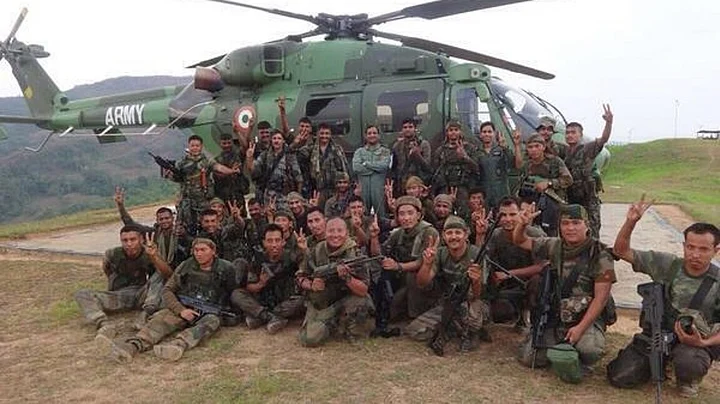Several uncomfortable questions have surfaced over the media reporting of the June 9 Special Forces’ assault on rebel bases on the India-Myanmar border.
There is much confusion about the casualties in the rebel ranks and the locations of the raids.
The assumption, encouraged by ministers and some retired military men, that these raids could be replicated to counter the ‘western disturbances’, also seems out of place.
An Almost Impossible Tale
Additional Director General of Military Operations Maj-Gen Ranbir Singh said in his first press conference that the Special Forces have ‘inflicted significant casualties’ on the rebels. Later, military sources placed the casualties at around 20, but the media quoting defence and home ministry sources have let imagination run riot. Some channels have quoted specific figures like 38, others have placed it between 100 and 150.
The triumphalism was sparked by junior Information Minister Rajyavardhan Singh Rathore’s claims of “strikes deep inside Myanmar”, which again seems to be totally untenable. Let’s examine the details emerging from media reports, all sourced to ministries and military officials – the strikes were ‘deep inside Myanmar’ the entire operation was over in 45 minutes. The commandos were dropped on the border by helicopters.
They trekked (some reports say even crawled) to rebel camps before hitting them. Those aware of ground realities in the jungles of Myanmar’s Sagaing Division (where the rebel camps were supposedly attacked) would know it is not possible to ‘strike deep inside Myanmar’ on foot and still finish off the operation in 45 minutes.
It would be too much to expect from even the toughest of commandos to make even 2-3 kilometres on the run with heavy weapons, hit the camps and de-induct within 45 minutes without suffering any casualties.
Even if the Special Forces had guides from anti-NSCN(Khaplang) rebels who have broken off from him, this would be well nigh impossible. There hangs a tale.
Panic, Triumphalism and the Media
If helicopters were used to drop commandos on the border, leaving them to trek a few kilometers at the dead of night in poor visibility (it is raining in Sagaing as in much of northeast now), alert rebel sentries can’t miss the noise of helicopters.
And rebels of NSCN-K and the Meitei groups are well trained and have standard drills to counter an assault – they would easily get to cover jungle tracks leading to the base in pre-selected ambush positions to welcome the assault group.
By all indications, the locations of the camps mentioned in media reports (sourced to ministry sources) are manned by assortment of rebels that include the tough fighters of Khaplang and Meitei groups — it is not left to those of the Kamtapur Liberation Organisation (KLO) or some such group who man these camps.
The Manipur Peoples Liberation Army (PLA) has admitted one of its ‘border transit camp’ was attacked by Indian troops but insist no damage was caused and the attack was repulsed.
The ULFA has backed that claim and the NSCN-K has denied any attack on their camp, suggesting the camp attacked by the Indian commandos was not theirs. Be it in mindless panic mongering or trumpeted triumphalism, the Myanmar raids have shown up the worst side of Indian media.
Learning From Tripura
A former colonel who headed a military think tank after retirement has insisted, rather significantly, that the commandos were not only dropped at the location by helicopters but also “provided firepower support by attack helicopters.”
His contacts in the military makes his account more believable. Indian attack helicopters may have gone for a dive-and-fire attack using heavy ammunition and the commandos may have slithered down to add to the damage in the confusion only to de-induct quickly before any counter-attack by the rebels.
But to hit a small rebel camp in dark from the sky in the thickly forested Sagaing terrain and claim it was a ‘surgical strike’ may be as incredible as Rathore’s claim of hitting “deep inside Myanmar.” In such strikes, there is no real chance to correctly assess casualties because one is not sure of the rebels’ strength.
Tripura’s Left government used surrendered rebels and Bangladeshi underworld to target ATTF and NLFT rebels inside Bangladesh between 2000 and 2005. Not less than 20 such raids were pulled off by Tripura police and Military Intelligence during these five years, neutralising tribal insurgency in the state.
That now gives Tripura the confidence to withdraw the Armed Forces Special Powers Act (AFSPA). But Manik Sarkar neither denies nor owns up the raids. Modi’s ministers in Delhi need to avoid needless triumphalism, unless they are seeking to gain political mileage by using the Myanmar raids to sabre-rattle with Pakistan.
(At The Quint, we question everything. Play an active role in shaping our journalism by becoming a member today.)
